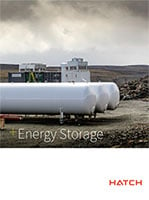Energy Storage
Abstract
The growing need for energy storage is being driven by the desire to reduce carbon emissions in the energy sector and the consequential increase of intermittent renewable power generation.
However, an ever-expanding range of opportunities exists for energy storage as investment rapidly drives down the cost of energy storage. The range of technologies becoming commercially viable is expanding and further creating opportunities that include: lowering carbon emissions, increasing grid resiliency and offsetting capital investment in transmission and distribution infrastructure. This report explores these technologies and applications and includes specific case studies of energy storage implementations.
The power grid is a closely controlled system in which generation and consumption must be constantly kept in balance. This has historically been done by forecasting the demand. The electricity demand is then met by using a combination of efficient baseload energy generation sources (such as nuclear facilities) and fast-responding but less efficient fossil fuel-based generating plants (peaker power plants). Substantial additions of intermittent renewable sources of power generation increase the challenges for grid operators to maintain the balance as new variability in the supply is added to the existing variability in the demand.

Energy Storage Paper Download
Find out how Hatch is making a difference - download our Energy Storage paper